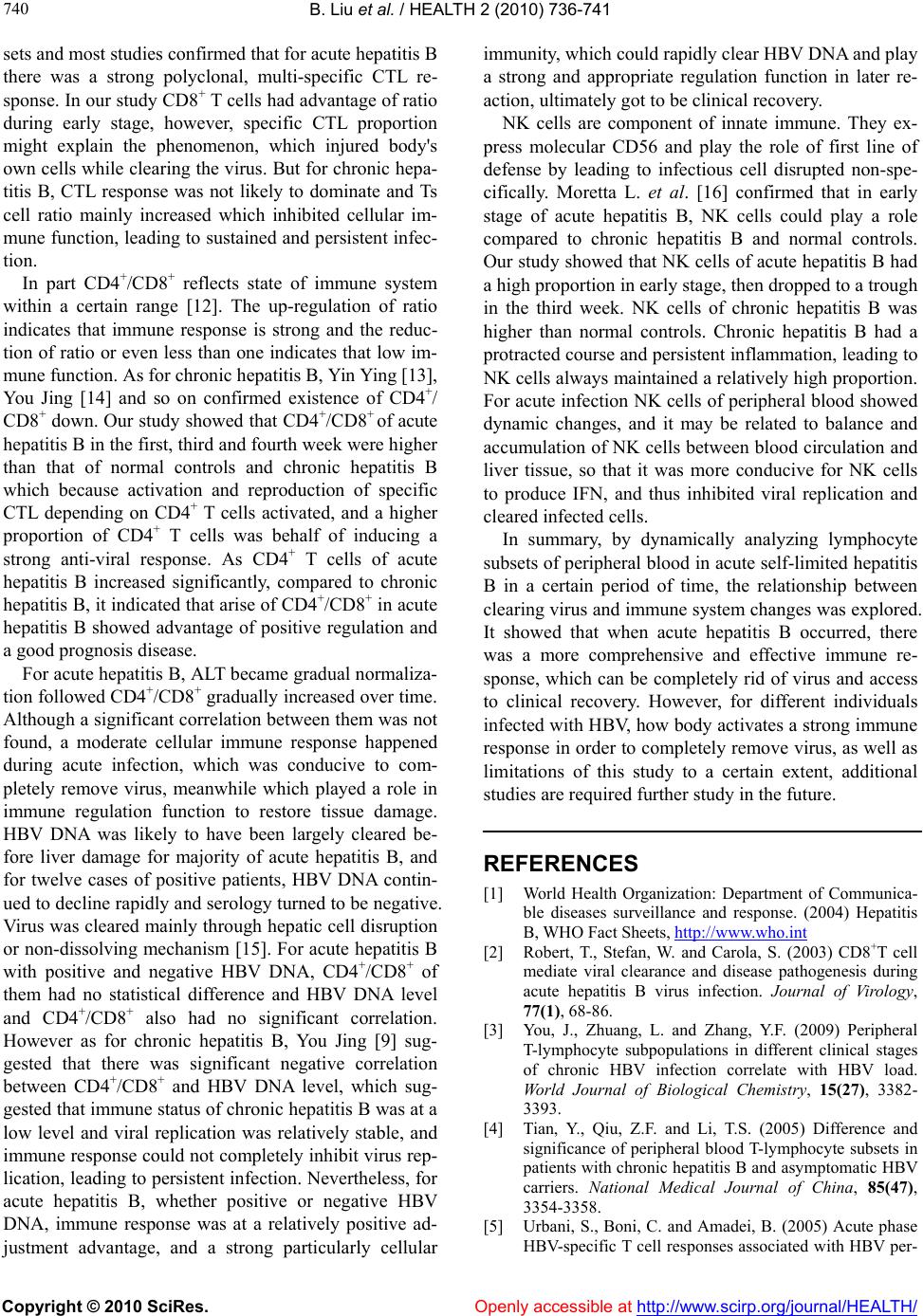
B. Liu et al. / HEALTH 2 (2010) 736-741
Copyright © 2010 SciRes. Openly accessible at http://www.scirp.org/journal/HEALTH/
740
sets and most studies confirmed that for acute hepatitis B
there was a strong polyclonal, multi-specific CTL re-
sponse. In our study CD8+ T cells had advantage of ratio
during early stage, however, specific CTL proportion
might explain the phenomenon, which injured body's
own cells while clearing the virus. But for chronic hepa-
titis B, CTL response was not likely to dominate and Ts
cell ratio mainly increased which inhibited cellular im-
mune function, leading to sustained and persistent infec-
tion.
In part CD4+/CD8 + reflects state of immune system
within a certain range [12]. The up-regulation of ratio
indicates that immune response is strong and the reduc-
tion of ratio or even less than one indicates that low im-
mune function. As for chronic hepatitis B, Yin Ying [13],
You Jing [14] and so on confirmed existence of CD4+/
CD8+ down. Our study showed that CD4+/CD8+ of acute
hepatitis B in the first, third and fourth week were higher
than that of normal controls and chronic hepatitis B
which because activation and reproduction of specific
CTL depending on CD4+ T cells activated, and a higher
proportion of CD4+ T cells was behalf of inducing a
strong anti-viral response. As CD4+ T cells of acute
hepatitis B increased significantly, compared to chronic
hepatitis B, it indicated that arise of CD4+/CD8+ in acute
hepatitis B showed advantage of positive regulation and
a good prognosis disease.
For acute hepatitis B, ALT became gradual normaliza-
tion followed CD4+/CD8+ gradually increased over time.
Although a significant correlation between them was not
found, a moderate cellular immune response happened
during acute infection, which was conducive to com-
pletely remove virus, meanwhile which played a role in
immune regulation function to restore tissue damage.
HBV DNA was likely to have been largely cleared be-
fore liver damage for majority of acute hepatitis B, and
for twelve cases of positive patients, HBV DNA contin-
ued to decline rapidly and serology turned to be negative.
Virus was cleared mainly through hepatic cell disruption
or non-dissolving mechanism [15]. For acute hepatitis B
with positive and negative HBV DNA, CD4+/CD8+ of
them had no statistical difference and HBV DNA level
and CD4+/CD8+ also had no significant correlation.
However as for chronic hepatitis B, You Jing [9] sug-
gested that there was significant negative correlation
between CD4+/CD8+ and HBV DNA level, which sug-
gested that immune status of chronic hepatitis B was at a
low level and viral replication was relatively stable, and
immune response could not completely inhibit virus rep-
lication, leading to persistent infection. Nevertheless, for
acute hepatitis B, whether positive or negative HBV
DNA, immune response was at a relatively positive ad-
justment advantage, and a strong particularly cellular
immunity, which could rapidly clear HBV DNA and play
a strong and appropriate regulation function in later re-
action, ultimately got to be clinical recovery.
NK cells are component of innate immune. They ex-
press molecular CD56 and play the role of first line of
defense by leading to infectious cell disrupted non-spe-
cifically. Moretta L. et al. [16] confirmed that in early
stage of acute hepatitis B, NK cells could play a role
compared to chronic hepatitis B and normal controls.
Our study showed that NK cells of acute hepatitis B had
a high proportion in early stage, then dropped to a trough
in the third week. NK cells of chronic hepatitis B was
higher than normal controls. Chronic hepatitis B had a
protracted course and persistent inflammation, leading to
NK cells always maintained a relatively high proportion.
For acute infection NK cells of peripheral blood showed
dynamic changes, and it may be related to balance and
accumulation of NK cells between blood circulation and
liver tissue, so that it was more conducive for NK cells
to produce IFN, and thus inhibited viral replication and
cleared infected cells.
In summary, by dynamically analyzing lymphocyte
subsets of peripheral blood in acute self-limited hepatitis
B in a certain period of time, the relationship between
clearing virus and immune system changes was explored.
It showed that when acute hepatitis B occurred, there
was a more comprehensive and effective immune re-
sponse, which can be completely rid of virus and access
to clinical recovery. However, for different individuals
infected with HBV, how body activates a strong immune
response in order to completely remove virus, as well as
limitations of this study to a certain extent, additional
studies are required further study in the future.
REFERENCES
[1] World Health Organization: Department of Communica-
ble diseases surveillance and response. (2004) Hepatitis
B, WHO Fact Sheets, http://www.who.int
[2] Robert, T., Stefan, W. and Carola, S. (2003) CD8+T cell
mediate viral clearance and disease pathogenesis during
acute hepatitis B virus infection. Journal of Virology,
77(1), 68-86.
[3] You, J., Zhuang, L. and Zhang, Y.F. (2009) Peripheral
T-lymphocyte subpopulations in different clinical stages
of chronic HBV infection correlate with HBV load.
World Journal of Biological Chemistry, 15(27), 3382-
3393.
[4] Tian, Y., Qiu, Z.F. and Li, T.S. (2005) Difference and
significance of peripheral blood T-lymphocyte subsets in
patients with chronic hepatitis B and asymptomatic HBV
carriers. National Medical Journal of China, 85(47),
3354-3358.
[5] Urbani, S., Boni, C. and Amadei, B. (2005) Acute phase
HBV-specific T cell responses associated with HBV per-